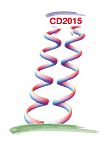Speaker
Takashi Inoue
(Nihon University)
Description
Explaining and predicting properties of nuclei starting from QCD is one of the most challenging problems in physics. There are several attempts to extract mass of nuclei in lattice QCD simulations, but direct extractions are limited only to very light nuclei, i.e. mass number A ≤ 4, due to computation costs and, more severely, due to several fundamental difficulties. We propose an alternative approach to study nuclei starting from QCD. We deduce mass and structure of 4He, 16O, and 40 Ca nuclei from QCD. First, we extract two-nucleon potentials in lattice QCD numerical simulations with the recently developed HAL QCD method, at large quark masses for the moment. Obtained QCD induced NN potentials posses common features of phenomenological ones, namely, strong repulsion at short distance, attraction at medium and long distance, and strong tensor force, although their strength are weaker due to the large quark masses. Accordingly, the potentials reproduce experimental two-nucleon scattering data qualitatively. Then, we apply the potentials to few-body technique or many-body theory to study the nuclei: a variational method for 4He and the Brueckner-Hartree-Fock (BHF) theory for 16O and 40Ca. We find that these nuclei are bound for a large quark mass corresponding to a pseudo-scalar meson mass of 469 MeV and a nucleon mass of 1161 MeV.
Fig. 1 (see the attached file) shows obtained ground state energy of 16O as a function of parameters used in our BHF calculation. Fig. 2 shows obtained single particle levels of 40Ca. Total binding energies, 5 MeV for 4He, 35 MeV for 16O, and 113 MeV for 40Ca, are rather smaller than the experimental data, but this is primarily because of the unrealistic quark mass in our lattice QCD simulation. This result shows that one can deduce properties of medium- heavy nuclei from QCD as well as light ones in the HAL QCD approach. This must be significant progress in nuclear physics.
References
1. T. Inoue et al. [HAL QCD Collaboration], Nucl. Phys. A881 (2012) 28.
2. T. Inoue et al. [HAL QCD Collaboration], Phys. Rev. Lett. 111 (2013) 11, 112503.
3. T. Inoue et al. [HAL QCD Collaboration], Phys. Rev. C91 (2015) 1, 011001.

